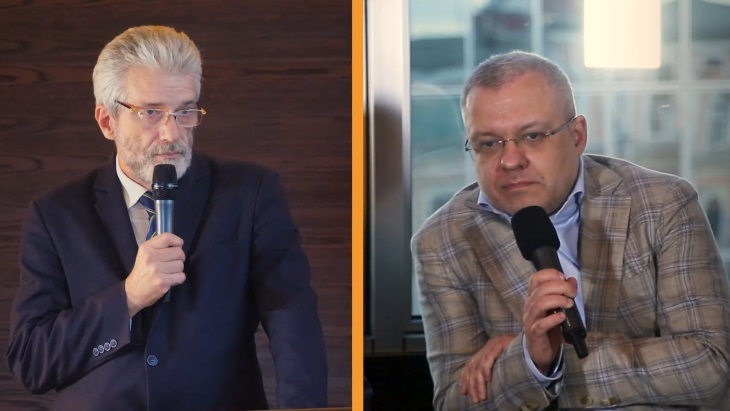Ukraine-EU 'energy bridge' still a realistic goal, says Energoatom vice president
21 October 2020
Energoatom has "various options" for attracting investment in the completion of the third and fourth units of the Khmelnitsky nuclear power plant (KhNPP), Herman Halushchenko, the company's vice president of development, said in an interview on the Energy Freedom talk show hosted by Energy Club on 19 October. Energoatom published a summary of the interview yesterday.
 Energy Freedom host Andrey Kulikov (left) and Energoatom vice president Herman Halushchenko (Image: Energoatom)
Energy Freedom host Andrey Kulikov (left) and Energoatom vice president Herman Halushchenko (Image: Energoatom)
"The first option," Halushchenko said, "is to take into account the investment component of 20 kopecks in the cost of producing a kilowatt-hour of electricity by nuclear power plants. This will make it possible to obtain the funds necessary for the completion of the power units within five years. And the second is switching KhNPP unit 2 to work in the EU energy system, and the funds received from the export of electricity will be used to complete the construction of units 3 and 4."
Disconnection of unit 2 from national grid and its transfer to the ENTSO-E network for the purpose of exporting Ukrainian nuclear power thus "remains a topical project", he said.
Energoatom operates all of Ukraine's four nuclear power plants - Zaporozhe, Rovno, South Ukraine and Khmelnitsky - which comprise 15 units. The Energy Bridge would link Khmelnitsky 2 to Burshtyn Energy Island and connect with power lines to Rzeszów in Poland and Albertirsa in Hungary.
The company will need to start decommissioning some of its units from 2030, which Halushchenko said recently will cost about UAH10 billion (USD350 million) per unit. It has no plans yet to build new units and its project to build Khmelnitsky units 3 and 4 has been put on hold. This project was part of Ukraine's so-called Energy Bridge, according to which it would have started supplying electricity to the EU network as early as 2019, and would complete the project by 2025.
In his interview with Energy Freedom, Halushchenk said the Energy Bridge project "ran into a number of obstacles and it is assumed that its implementation is impossible".
"On the one hand, we are told that the Polish side does not see the point of this project; on the other hand, they note that in 2023 full synchronisation of the United Power System of Ukraine with ENTSO-E is expected, and this also makes it impractical. But I would not be so categorical in assessing the Energy Bridge because this project is already five years old and in preparation for its implementation a consortium was created, which included leading Western energy companies, in particular French EDF, American Westinghouse and Polish Polenergia," he said.
Whatever the position of the Polish side is now, he said, there are still opportunities for the implementation of the project.
"Its main advantage is the actually existing direct KhNPP-Rzeszow 750 kV power transmission line, built in the times of the USSR. It would cost about half a billion dollars to build a line of such length and capacity today from scratch," he said.
He stressed that Westinghouse has "not lost interest" in the Energy Bridge project. "We recently discussed this project with Westinghouse representatives and heard their interest in making it happen. Perhaps it will not be in the form in which it was originally planned, but in any case we at Energoatom are above all interested in the project," he said.
In August last year a commission of Ukraine's Ministry of Energy announced that Ukraine Power Bridge Company Limited LLC had won its tender to select a partner for the public-private Energy Bridge project.
Researched and written by World Nuclear News